Introduction
Design
Front
{{section_header}}{{section.name}}{{/section_header}}

Back
{{section_header}}{{section.name}}{{/section_header}}

Left
{{section_header}}{{section.name}}{{/section_header}}
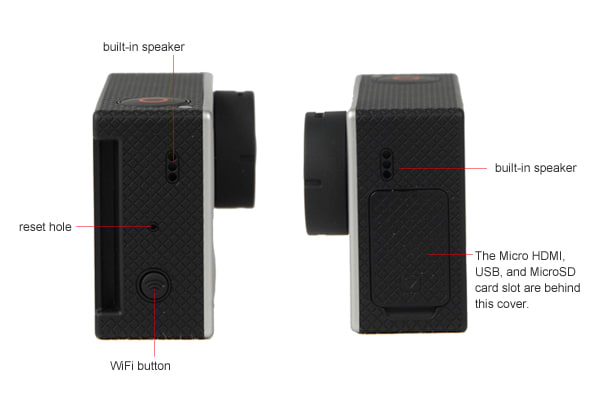
Right
{{section_header}}{{section.name}}{{/section_header}}
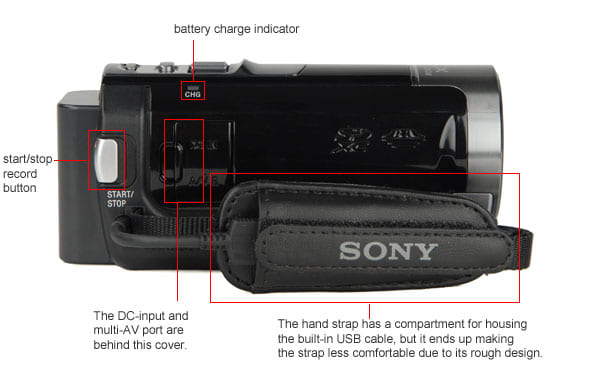
Top
{{section_header}}{{section.name}}{{/section_header}}

Bottom
{{section_header}}{{section.name}}{{/section_header}}

Size & Weight Comparison
{{section_header}}{{section.name}}{{/section_header}}
In the Box
{{section_header}}{{section.name}}{{/section_header}}

Performance
Color
{{section_header}}{{section.name}}{{/section_header}}
As we saw with last year's Kodak Zx1, the Zi8 had trouble properly white balancing its image in our bright light test. As a result, the camcorder showed very poor color accuracy in this test, although it did do significantly better than the Zx1. We're disappointed that Kodak wasn't fully able to correct this issue, however, because it means the camcorder is likely to garner poor color results under indoor lighting. More on how we test color.
You can see in the test chart above and the sample color image below that the Zi8 produced a strong yellow tint with its bright light image. This is the white balancing error we mentioned previously. The colors do look strong—the saturation level was 122%—but since the whole image has a warm-yellow tint, the colors are not accurate.
The Zi8 didn't have problems under all kinds of light—the camcorder did much better with the LED lights in our low light testing. Also, the Zi8 appeared to have no trouble white balancing when we used it outdoors. It was really just the halogen bulbs we use for our bright light testing that gave the camcorder trouble (some fluorescent lighting was also problematic for the Zi8).
By looking at the close-ups below, you can see that Kodak did improve things over last year's Zx1. The colors are much more accurate than last year and don't have nearly the amount of orange-yellow tint. Still, the Zi8 was no match for the color accuracy we measured on the Flip UltraHD and the JVC Picsio GC-FM1.
{{comparison_bars title="Color Score Comparison", attribute="Color Score", xLabel="Color Score"}}
Low Light Color
{{section_header}}{{section.name}}{{/section_header}}
The Kodak Zi8 was able to white balance properly in our low light testing, so the camcorder did much better with low light color accuracy than in our bright light test. The camcorder measured a color error of 4.53 with a saturation level of 110% in low light. These scores are both fairly good for an ultracompact camcorder (although the Kodak Zx1 was better... again). More on how we test low light color.
As you can see from the comparison images below, the Kodak Zi8 rendered a bright, colorful image in low light. Its image isn't as dark as the one captured by the Zx1 and it has better saturation than the JVC GC-FM1's image. The Flip UltraHD produced a slight green-yellow hue in low light, which made its low light picture somewhat undesirable.
Noise
{{section_header}}{{section.name}}{{/section_header}}
The Zi8 did a halfway decent job in our bright light noise test, but its results weren't stellar by any means. The camcorder measured 0.8375% noise in our testing, which is an above-average score for an ultracompact camcorder. Since the Zi8 has a focal length of 100cm (39 inches) to infinity, we had trouble getting our test images framed correctly and in focus. Anything closer than 100cm is entirely out of focus on the camcorder—unless you get really close (under 15cm) and switch to tele macro mode. More on how we test noise.
As we explained above, the image from the Zi8 appears blurry because, according to Kodak, the camcorder cannot focus on subjects that are between 15cm and 100cm away. The chart above was shot at roughly a 100cm distance, but the Zi8 still had trouble producing a crisp image at this focal length. The point is, you shouldn't shoot anything with the Zi8 unless you're a good distance away from it (like 4-5 feet).
{{comparison_bars title="Noise Score Comparison", attribute="Noise Score", xLabel="Noise Score"}}
Low Light Sensitivity
{{section_header}}{{section.name}}{{/section_header}}
The Kodak Zi8 needed 11 lux of light to reach 50 IRE on our waveform monitor. This isn't a bad performance, but other ultracompacts have done a lot better—including last year's Zx1 from Kodak (needed just 6 lux). Of course, the Zx1 was able to perform better on this test because of its lower pixel count. Results from all four of these camcorders are based on performance at 30p. More on how we test low light sensitivity.
{{comparison_bars title="Low Light Sensitivity Comparison", attribute="Low Light Sensitivity Score", xLabel="Low Light Sensitivity Score"}}
Low Light Noise
{{section_header}}{{section.name}}{{/section_header}}
The Zi8 averaged 1.0675% noise in our low light test, which is a good score for the little camcorder. As you can see in the crops below, the Zi8 didn't retain a very sharp image in low light despite its good noise performance. Its image is blurred and you can barely make out any fine details—even more so than the Kodak Zx1 from last year. There may not be much noise, but there's also very little detail. More on how we test low light noise.
All of the camcorders shown above did a good job in our low light noise test, but it was the Flip UltraHD and the JVC GC-FM1 that were able to retain the most sharpness in low light. You can also clearly see the discoloration produced by the Flip UltraHD in the cropped image above.
{{comparison_bars title="Low Light Noise Score Comparison", attribute="Low Light Noise Score", xLabel="Low Light Noise Score"}}
Low Light Color
{{section_header}}{{section.name}}{{/section_header}}
The Kodak Zi8 was able to white balance properly in our low light testing, so the camcorder did much better with low light color accuracy than in our bright light test. The camcorder measured a color error of 4.53 with a saturation level of 110% in low light. These scores are both fairly good for an ultracompact camcorder (although the Kodak Zx1 was better... again). More on how we test low light color.
As you can see from the comparison images below, the Kodak Zi8 rendered a bright, colorful image in low light. Its image isn't as dark as the one captured by the Zx1 and it has better saturation than the JVC GC-FM1's image. The Flip UltraHD produced a slight green-yellow hue in low light, which made its low light picture somewhat undesirable.
Motion
{{section_header}}{{section.name}}{{/section_header}}
The Zi8 did quite well in our motion test. The camcorder offered similar results as last year's Kodak Zx1, except the Zi8 had less artifacting. The Zi8's 1080/30p mode generally looked decent, and it probably captured the smoothest video of the 30p ultracompact camcorders we've tested. If you want an even smoother image, you can shoot with the Zi8's lower-resolution 720/60p setting. More on how we test motion.
Video Sharpness
{{section_header}}{{section.name}}{{/section_header}}
The Zi8 didn't do as well on our sharpness test as most of the other ultracompact camcorders that can record HD video. The camcorder didn't do all that bad, however, as it measured a horizontal sharpness of 600 lw/ph and a vertical sharpness of 500 lw/ph. These numbers are very similar to what we measured on the Kodak Zx1 last year. More on how we test video sharpness.
{{comparison_bars title="Video Sharpness Score Comparison", attribute="Video Sharpness Score", xLabel="Video Sharpness Score"}}
Stabilization
{{section_header}}{{section.name}}{{/section_header}}
The Kodak Zi8 is the first ultracompact camcorder we've tested that has a stabilization feature that you can manually turn on or off (the Sanyo VPC-CG10 also had this option, but that isn't exactly the same kind of device). The stabilization system is digital, which means it may degrade your image quality when used. Also, not so surprisingly, the Zi8's stabilization feature didn't appear to have much of an effect in our testing. More on how we test stabilization.
In our low shake test, the Zi8's digital stabilization system actually made the image shakier—probably because the camcorder overcompensated in an attempt to stabilize the image. In our high shake test we saw a slight improvement with the stabilization turned on, but only by a measly 2%.
In the Zi8's defense, we did notice the camcorder's stabilization system working somewhat effectively when used the camcorder's digital zoom. We don't test stabilization with digital zoom engaged, however, because the zoom degrades image quality and our standard is to test all camcorders at maximum optical zoom with our stabilization test. You can see an example video from our stabilization test below:
Neither the Kodak Zx1 and Flip UltraHD offer any stabilization settings, while the JVC GC-FM1 does have a digital image stabilization system. The thing is, JVC doesn't let you turn its stabilization setting on or off with the GC-FM1, so we have no way of testing how well it works.
Testing Samples
{{section_header}}{{section.name}}{{/section_header}}
Usability
Ease of Use
{{section_header}}{{section.name}}{{/section_header}}
Much like Kodak's previous camcorders, the Zi8 is a simple camcorder that is easy to use. It is basically a point-and-shoot device, which means you don't have to worry about any manual controls or settings. Now, with that being said, the Zi8's interface is significantly more complex than what you'd find on a Flip camcorder. The Zi8 actually has a menu system with roughly nine options, while the Flip's menu only lets you set the date and turn off record sounds/lights. The Zi8 also has multiple recording settings and frame rate options (four, to be exact), and it can capture still photos—all features that aren't anywhere to be found on the Flip UltraHD (or any Flip camcorder for that matter). Make sure you take these things into consideration when you're shopping for an ultracompact camcorder; do you want the easiest product to use, or one that affords you more choices and settings?
Compared to a regular camcorder, the Zi8's menu is very simple (it only has nine options). The problem, however, is that the menu has no text labels, which means all the options are represented by somewhat cryptic icons. Some of these icons are easy to understand (like the date icon represented by a calendar), but others make no sense at all. This forces you to read the manual in order to figure out what certain menu options actually do. For this reason, we found the Zi8 a bit more difficult to use than last year's Kodak Zx1, although the two camcorders have a similar interface.
Speaking of the Zi8's instruction manual... we're not really crazy about it. The manual does explain most of the camcorder's settings and options, but we found some erroneous information (like saying the audio level control only works with the external mic—not true), and a few details were left out of the manual entirely.
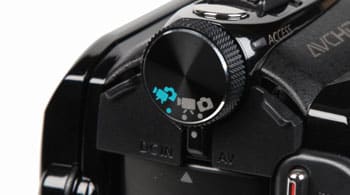
Auto Mode is confusingly called Dual Shot mode
Auto Mode
{{section_header}}{{section.name}}{{/section_header}}
The Zi8 is a mostly automated camcorder. You can't control shutter speed or aperture manually, there is no autofocus mechanism (the lens is fixed), and the only thing you really do have control over is the 4x digital zoom and video resolution.
The camcorder does a good job with auto exposure, and we often noticed smooth transitions between light and dark scenes. The Zi8 does have a limited face detection feature as well. We know this feature detects faces—a big yellow box appears around faces when it's turned on—but since the Zi8 doesn't have an autofocus system it seems all the face detection feature does is adjust exposure levels. We noticed this occurring, but it didn't seem to work much differently than the camcorder's regular auto exposure system with the face detection feature turned off.
If you read our bright light color performance section, you already know the Zi8 has a terrible problem with white balance. The camcorder couldn't white balance properly with our halogen bulbs (which we use in our bright light testing), although it seemed to work okay under outdoor light and most other indoor light. Our halogen bulbs gave the Zi8's image a strong orange hue throughout the frame, and the camcorder simply couldn't compensate. Still, the Zi8's auto white balance was a bit better than last year's Kodak Zx1.
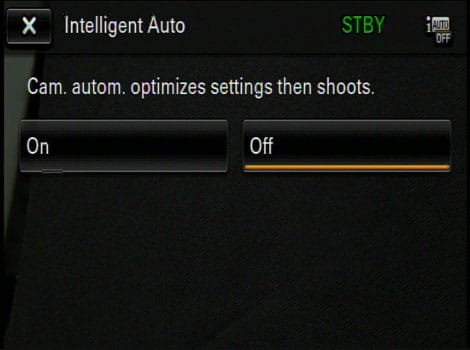
The iAuto mode button is difficult to find, but when you do find it the option for turning on the mode looks like this.
Other Auto Features
Handling
{{section_header}}{{section.name}}{{/section_header}}
The Zi8 has a durable construction, but its slick surface can make it somewhat difficult to grip. The camcorder does come with a tiny wrist strap, but we didn't find it all that helpful. The best thing about the Zi8's design is its thin, rectangular shape that makes it very easy to slip into your pocket. The camcorder is almost exactly as tall as an iPhone, although it is a bit thicker (particularly near the top). One problem with the Zi8 is that it is very difficult to get the camcorder to stand on its own on a flat surface. Why do manufacturers insist on making camcorders that have rounded bottoms rather than a flat, even base?

The Zi8 has better buttons than the Kodak Zx1, but the construction of these buttons is still not very impressive. The buttons don't offer much haptic feedback, they're very close together, and some of them have multiple functions in different modes (for example, the playback button acts as the slow motion button in playback mode).

The most important button on the camcorder—the navigation joystick that doubles as the start/stop record button—is a decent size and is placed well in the center of the camcorder. After a lot of use, however, we noticed the joystick started to stick towards the left side. This stickiness made for an annoying experience when we used the joystick to shuffle through videos during playback or navigate menus. About a third of the time we pushed the joystick to the left, the joystick would act as though we had pushed it in to make a selection. We're not sure if this issue will come up on all Zi8's, but it was definitely a problem on ours—and we feel that it is a sign of poor construction.

Lastly, we're really bugged by the problematic focal range offered on the Zi8. With the camcorder's normal focus setting you have to be at least 100cm (39 inches) away from your subject for it to be in focus. In our testing, we found that it was actually better to be about 150cm away to ensure proper focus. If you're any closer, your video will appear soft and blurred. This is a major problem because you can't always tell if your video is in focus when you look on the LCD (the screen is too small and its resolution isn't good enough). This means you could spend a whole day shooting, only to come home and realize much of your footage is completely out of focus. If you want to shoot ultra-closeups with the camcorder, you can switch to macro mode. In this mode, everything 15cm or closer will be in focus. This still leaves the camcorder with a glaring gap of not being able to focus on anything between 15cm–100cm away.

These dedicated buttons give you quick access to aperture and shutter speed controls.
Portability
{{section_header}}{{section.name}}{{/section_header}}
We classify the Kodak Zi8 as an ultracompact camcorder, which means the model was made with an emphasis on portability. The Zi8 is a bit lighter than last year's Kodak Zx1, but that is mainly due to the fact that the Zx1 relied on heavy AA batteries instead of a small, lithium-ion battery like the Zi8. As far as size goes, the Zi8 is actually slightly bigger than most ultracompact camcorders, but this size differential isn't that big of a deal. The Zi8 is small enough—and shaped perfectly—for pocket transport.
Battery Life
{{section_header}}{{section.name}}{{/section_header}}
The Zi8 uses a rechargeable lithium-ion battery that lasted for around 80 minutes in our battery life test (1 hour, 20 minutes, 9 seconds). This is a significantly worse performance than the Kodak Zx1 gave us with its AA batteries (the Flip UltraHD also did better in this test with its AA batteries). So, this leaves a question for the consumer—do you prefer longer battery life, but with heavier AA batteries, or do you want to sacrifice battery life in exchange for a lighter, rechargeable battery pack? More on how we test battery life.
One of the good things about the Zi8 is that you can recharge its battery via its built-in USB cable, or by plugging it into a wall outlet with its DC-input. The battery compartment is enclosed, however, so you cannot upgrade to larger battery packs for longer-lasting performance.

{{comparison_bars title="Battery Life Comparison", attribute="Battery Life Score", xLabel="minutes"}}
LCD & Viewfinder
{{section_header}}{{section.name}}{{/section_header}}
The Kodak Zi8 has a larger LCD than most ultracompact camcorders, but the screen still isn't that impressive. It cannot rotate or swivel (it is entirely stationary on the back of the camcorder), and its resolution is a lackluster 230,000 pixels. You can adjust the brightness of the screen in the camcorder's menu, however, which is a feature not available on many ultracompact camcorders.
The Zi8 doesn't have a viewfinder, which is the norm for a camcorder of its class. There has yet to be a real ultracompact model that features an electronic viewfinder.
Stabilization
{{section_header}}{{section.name}}{{/section_header}}
The Kodak Zi8 is the first ultracompact camcorder we've tested that has a stabilization feature that you can manually turn on or off (the Sanyo VPC-CG10 also had this option, but that isn't exactly the same kind of device). The stabilization system is digital, which means it may degrade your image quality when used. Also, not so surprisingly, the Zi8's stabilization feature didn't appear to have much of an effect in our testing. More on how we test stabilization.
In our low shake test, the Zi8's digital stabilization system actually made the image shakier—probably because the camcorder overcompensated in an attempt to stabilize the image. In our high shake test we saw a slight improvement with the stabilization turned on, but only by a measly 2%.
In the Zi8's defense, we did notice the camcorder's stabilization system working somewhat effectively when used the camcorder's digital zoom. We don't test stabilization with digital zoom engaged, however, because the zoom degrades image quality and our standard is to test all camcorders at maximum optical zoom with our stabilization test. You can see an example video from our stabilization test below:
Neither the Kodak Zx1 and Flip UltraHD offer any stabilization settings, while the JVC GC-FM1 does have a digital image stabilization system. The thing is, JVC doesn't let you turn its stabilization setting on or off with the GC-FM1, so we have no way of testing how well it works.
Manual Focus
{{section_header}}{{section.name}}{{/section_header}}
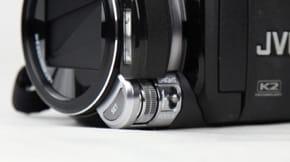
The adjustment dial makes accurate focus adjustments easy.
Manual Exposure
{{section_header}}{{section.name}}{{/section_header}}
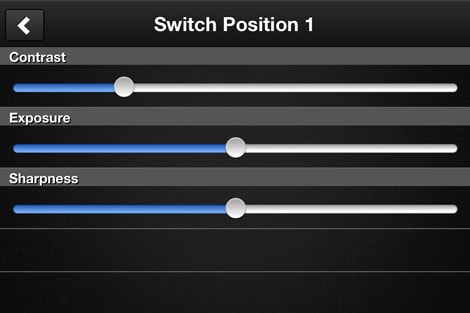
The manual exposure controls are only found on the Contour app, not on the camcorder itself.
Miscellaneous Controls
{{section_header}}{{section.name}}{{/section_header}}
Color & Image Controls
The Zi8 doesn't have any color or image controls to speak of.
Macro Focus
On the top of the Zi8 is a slider that allows you to switch between normal and macro focus settings. Using macro focus switches the focal range to 15cm or less (while the normal range is 100cm—infinity).
Audio Controls
{{section_header}}{{section.name}}{{/section_header}}
For ultracompact camcorders we normally don't have anything to talk about in this section of the review. Things are different with the Kodak Zi8, however. It has a 3.5mm external microphone jack and you can manually adjust the audio on the camcorder. Strangely, Kodak's instruction manual says the audio level adjustment only works if an external mic is attached, but we found the level adjustment worked fine with the built-in mic as well.
Speaking of the built-in microphone, it is located on the front of the camcorder and it can record stereo audio. The built-in mic isn't spectacular, but it does work, and it is located out of the way from wandering fingers or noisy buttons. The cool thing about having an external mic port on the Zi8 is that you could theoretically use the camcorder as a simple audio recording device. It is definitely small enough for this purpose and the audio level controls allow you to adjust the recording volume to your liking.
Editing
{{section_header}}{{section.name}}{{/section_header}}
The Kodak Zi8 has software embedded on the camcorder itself, so you simply connect the camcorder to your computer and you can install the software. This software, however, is only compatible with Windows. For an overview of the software that ships with this and other camcorders, see our article: Video Editing Software For Your Camcorder{{product.brand.name}}-Included-Software.htm.
Features
Compression
{{section_header}}{{section.name}}{{/section_header}}
The Kodak Zi8 uses the H.264 codec to compress video. The camcorder has a Full HD setting (1080/30p), as well as two 720p HD options. You can also shoot standard definition video with the Zi8 using its WVGA setting. Read more about the advantages and disadvantages of various high definition compression types.
Media
{{section_header}}{{section.name}}{{/section_header}}
The Kodak Zi8 records video and photos to removable SD/SDHC memory cards. The camcorder also has a limited amount of internal memory, but most of it is taken up by the embedded editing software located on the camcorder. This leaves roughly 20MB of space left on the camcorder that can actually be used to store videos or photos (that's good for about 15 seconds of HD video or a few still images).
Having an SD/SDHC memory card slot is something that sets the Zi8 apart from the Flip series of camcorders, which only record to internal memory (the Flip UltraHD has 8GB of internal memory). Most ultracompact camcorders other than Flip models have memory card slots rather than solely relying on internal memory. Kodak doesn't provide any approximate record times for the Zi8's Full HD setting, but the specs do say that the camcorder can record roughly 20 minutes per 1GB in 720/30p mode. Read more about the advantages and disadvantages of various media types.

Slow Motion Modes
Still Features
{{section_header}}{{section.name}}{{/section_header}}
The Kodak Zi8 can take 5-megapixel still images (interpolated), but that is all it can do as far as still features are concerned. The camcorder takes photos in one size only—3072 x 1728—and it has no continuous shooting options, built-in flash, or self-timer. You also cannot take still photos while you are recording video, as you must switch over to photo mode. The Flip series does not take still photos at all.
The Kodak Zi8 did roughly as well on our still color accuracy test as it did on our bright light video color accuracy test. The camcorder earned a color error of 7.98 with a saturation level of 96.61%. This color error score isn't very good, but it is better than what the Kodak Zx1 and JVC Picsio GC-FM1 earned on this test.
The Kodak Zi8 only takes photos with a 16:9 aspect ratio (it only takes one size of photo as well—3072 × 1728). The Zi8 did a better job white balancing than last year's Zx1. The JVC GC-FM1 has more photo options, but its still photos aren't really any better than what you get with the Zi8. The Flip UltraHD does not take still photos.
The Zi8 actually did quite well with this test, registering 0.65% noise in its still images. This is a better score than last year's Zx1 reported and it is a lot better than the 1.55% noise measured on the JVC GC-FM1's still images.
The Kodak Zi8 measured a horizontal sharpness of 1084 lw/ph with 9.7% oversharpening. The vertical sharpness came in at 513 lw/ph with 25.9% undersharpening. These scores are marginally better than what the Kodak Zx1 and JVC GC-FM1 earned on this test, but only by the smallest of fractions. So, what you should come away from this info is that the Zi8 can take 5 megapixel still photos, but the actual sharpness of the still images isn't very good. You're better off using a cheap dedicated still camera for snapping photographs.
Lens & Imaging System
{{section_header}}{{section.name}}{{/section_header}}

The Kodak Zi8, like most ultracompact camcorders, has a fixed lens. This means the lens has no focus system, but instead offers a focal range of 100cm–infinity. You can also switch the camcorder into macro focus mode to focus on subjects closer than 15cm. The problem with this whole setup is that the Zi8 cannot focus on anything that is between 15cm–100cm (½ foot to 3½ feet) away. We ran into this problem many times during our testing. We'd think we were far enough away from our subject for it to be in focus, but when we played back the footage everything looked soft.
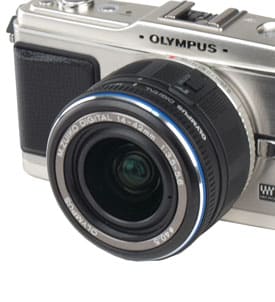
LCD & Viewfinder
{{section_header}}{{section.name}}{{/section_header}}
The Kodak Zi8 has a larger LCD than most ultracompact camcorders, but the screen still isn't that impressive. It cannot rotate or swivel (it is entirely stationary on the back of the camcorder), and its resolution is a lackluster 230,000 pixels. You can adjust the brightness of the screen in the camcorder's menu, however, which is a feature not available on many ultracompact camcorders.
The Zi8 doesn't have a viewfinder, which is the norm for a camcorder of its class. There has yet to be a real ultracompact model that features an electronic viewfinder.
Connectivity
{{section_header}}{{section.name}}{{/section_header}}
The Kodak Zi8 has more ports than most ultracompact camcorders. On its left side is a 3.5mm external microphone jack, an AV-out port, HDMI terminal, and DC-input. The mic jack and DC-input are both unprotected, while the AV and HDMI ports are covered by a flimsy plastic flap. The AV-out port is also smaller than a regular AV port (it is 2.5mm instead of 3.5mm) and it only carries a monaural audio signal (the camcorder comes with a mono AV cable).
On the right side of the camcorder is a built-in USB arm as well as a SD/SDHC memory card slot. The USB arm on the Zi8 is more practical than the ones featured on Flip camcorders, but it still isn't that great. The Zi8's USB arm has a flexible tether and it doesn't 'flip' out from the camcorder with a spring-loaded release. The problem is, the tether is very short, so it can still be awkward to actually connect the camcorder to a computer's USB terminal.
You can power the Zi8 by connecting its USB arm to a USB port on a powered computer, or by plugging in the provided power adapter into the camcorder's DC-input. The strange thing about the power adapter is that it has a normal DC-input connection that goes into the camcorder, but it has a USB connection at the other end. The camcorder also comes with a wall-plug adapter for this USB connection—so, ultimately, you can recharge the camcorder's battery via USB or a wall-outlet. If you connect the Zi8 to a computer by using its DC-USB cable, however, you cannot transfer files this way. This is only possible if you use the Zi8's built-in USB arm. We're happy to see Kodak include all these options for powering the Zi8, but, frankly, it does get a bit confusing when you try to explain them all.
Battery
{{section_header}}{{section.name}}{{/section_header}}
One of the good things about the Zi8 is that you can recharge its battery via its built-in USB cable, or by plugging it into a wall outlet with its DC-input. The battery compartment is enclosed, however, so you cannot upgrade to larger battery packs for longer-lasting performance.

Media
{{section_header}}{{section.name}}{{/section_header}}
The Kodak Zi8 records video and photos to removable SD/SDHC memory cards. The camcorder also has a limited amount of internal memory, but most of it is taken up by the embedded editing software located on the camcorder. This leaves roughly 20MB of space left on the camcorder that can actually be used to store videos or photos (that's good for about 15 seconds of HD video or a few still images).
Having an SD/SDHC memory card slot is something that sets the Zi8 apart from the Flip series of camcorders, which only record to internal memory (the Flip UltraHD has 8GB of internal memory). Most ultracompact camcorders other than Flip models have memory card slots rather than solely relying on internal memory. Kodak doesn't provide any approximate record times for the Zi8's Full HD setting, but the specs do say that the camcorder can record roughly 20 minutes per 1GB in 720/30p mode. Read more about the advantages and disadvantages of various media types.

Still Features
{{section_header}}{{section.name}}{{/section_header}}
The Kodak Zi8 can take 5-megapixel still images (interpolated), but that is all it can do as far as still features are concerned. The camcorder takes photos in one size only—3072 x 1728—and it has no continuous shooting options, built-in flash, or self-timer. You also cannot take still photos while you are recording video, as you must switch over to photo mode. The Flip series does not take still photos at all.
The Kodak Zi8 did roughly as well on our still color accuracy test as it did on our bright light video color accuracy test. The camcorder earned a color error of 7.98 with a saturation level of 96.61%. This color error score isn't very good, but it is better than what the Kodak Zx1 and JVC Picsio GC-FM1 earned on this test.
The Kodak Zi8 only takes photos with a 16:9 aspect ratio (it only takes one size of photo as well—3072 × 1728). The Zi8 did a better job white balancing than last year's Zx1. The JVC GC-FM1 has more photo options, but its still photos aren't really any better than what you get with the Zi8. The Flip UltraHD does not take still photos.
The Zi8 actually did quite well with this test, registering 0.65% noise in its still images. This is a better score than last year's Zx1 reported and it is a lot better than the 1.55% noise measured on the JVC GC-FM1's still images.
The Kodak Zi8 measured a horizontal sharpness of 1084 lw/ph with 9.7% oversharpening. The vertical sharpness came in at 513 lw/ph with 25.9% undersharpening. These scores are marginally better than what the Kodak Zx1 and JVC GC-FM1 earned on this test, but only by the smallest of fractions. So, what you should come away from this info is that the Zi8 can take 5 megapixel still photos, but the actual sharpness of the still images isn't very good. You're better off using a cheap dedicated still camera for snapping photographs.
Other Features
{{section_header}}{{section.name}}{{/section_header}}
NTSC/PAL output
You can switch the output on the Zi8 between the NTSC or PAL signals. This is a common feature for ultracompact camcorders, as it means companies only have to manufacture one model that can work in both North American and overseas. Switching to PAL output won't change the way the camcorder records video, but it will enable you to connect the Zi8 to a PAL television.
Pure Digital Flip UltraHD Comparison
We didn't notice much of an improvement in video performance on the Kodak Zi8 compared to last year's Zx1, despite the fact that Kodak significantly upgraded the internal hardware. Yes, the Zi8 captures a Full HD image (compared to 720p on the Zx1), but its sharpness scores weren't really much better than what we measured on the Zx1. This, along with the fact that the Zi8 did worse in low light than the Zx1, is highly disappointing.
The area where Kodak did improve things for the Zi8 is in handling. The Zi8 has much better button design and better labels than the Zx1, which had some of the worst buttons we have ever seen on a consumer camcorder. Still, things definitely weren't perfect with the Zi8's interface—it's joystick showed durability issues and it's menu options were terribly labeled.
Other benefits of the Zi8 include its external mic jack, audio level controls, and the fact that it runs on a rechargeable battery (as opposed to the Zx1's usage of AA batteries). Overall, the Zi8 represents a minor improvement over the Zx1, and we can't recommend purchasing either camcorder in place of the Flip UltraHD (unless the Zi8's audio features and still image capabilities are of utmost importance to you).
JVC GC-FM1 Comparison
The Flip UltraHD and the rest of the Flip series of camcorders have been our favorite ultracompact models for quite some time. The Flip may not have as many features as the Kodak Zi8, but it makes up for this fact by being incredibly easy to use and having a fool-proof interface. The Flip UltraHD also did pretty darn well in our testing, and it demolished the Zi8 in nearly every one of our performance categories—despite the fact that the UltraHD tops out with a 1280 x 720 video resolution.
You're not going to get top-notch video performance with any of these ultracompact camcorders, so the most important thing to focus on with these models is ease of use and handling. The Flip does incredibly well in this category and its provided editing software (that is both Mac and PC compatible) is the best of the bunch. If you want the most seamless experience for getting videos from the camcorder and onto the web, choose the Flip UltraHD. All the other ultracompact camcorders we've reviewed—including the Zi8—created far more headaches when we used them.
Keep in mind, however, the Flip UltraHD is a very simple camcorder. It doesn't take still photos, it doesn't have an memory card slot, and it runs on regular AA batteries (it ships with a rechargeable set). It also doesn't have many ports, and its USB arm is more gimmicky than anything else (it offers no flexibility when you connect the camcorder to a computer). Despite all this, the Flip is still the best ultracompact camcorder on the market and it gets the job done in a far better fashion than the Kodak Zi8.
COMP 3
The JVC GC-FM1 is an odd little camcorder for a couple of reasons. The camcorder did very well in most of our video performance tests. In fact, it did a lot better than the competition when it came to things like sharpness and color accuracy. What we hated about the GC-FM1, however, was its construction. The camcorder's macro focus slider switch was loose on both models we received from JVC. This meant the image captured by the FM1 wasn't always in focus, and you often had to jiggle the macro focus slider to make the image look crisp.
The camcorder's unprotected ports and strange, glittery design also made us weary about its durability. For a camcorder that is likely going to be transported in a pocket or at the bottom of a purse you definitely want something that is well-constructed. If these issues don't scare you off, however, the GC-FM1 can capture a surprisingly good image. Like the Zi8, the GC-FM1 isn't nearly as simple to use as a Flip camcorder, but it does offer a decently streamlined user experience. We just hope JVC would combine the video performance from the FM1 and put it into a more durable body.
Conclusion
The Zi8 ($199 MSRP) definitely represents an improvement for Kodak, but the camcorder was a disappointment overall. Even with its larger sensor, increased pixel count, and Full HD video recording, the Zi8 managed a lackluster performance in most of our video tests—sometimes coming in with worse numbers than last year's Kodak Zx1.
So, why do we say the Zi8 is an improvement for Kodak? Well, the camcorder has a much better design than the Zx1 and it feels like Kodak is moving in the right direction with improved auto white balance (though it still wasn't very good) and a Full HD recording option. The inclusion of a 3.5mm external microphone jack is also a smart, unique feature that helps set the Zi8 apart from the competition.
We still feel Kodak has some distance to cover before we can recommend one of its camcorders over any of the Flip models. Our advice to Kodak is to keep things as simple as possible and to build on the Zi8's strengths—like its durable construction and unique audio features. If Kodak continues to do this, and is able to improve on the Zi8's video performance, it could eventually rise above the rest of the ultracompact camcorders on the market.
Photo Gallery
{{photo_gallery "Front Photo", "Left Photo", "Left Open Photo", "Back Photo", "Right Photo", "Top Photo", "Bottom Photo", "Lens Photo", "Lens Photo 2", "3D Lens Photo", "Media Photo", "Easy Mode Photo", "Manual Controls Photo", "Zoom Photo", "Zoom Photo 2", "Ease of Use Photo", "Battery Photo", "LCD Photo 1", "LCD Photo 2", "EVF Photo 1", "EVF Photo 2", "Mic Photo", "Mic Photo 2", "Ports Photo 1", "Ports Photo 2", "Ports Photo 3", "Ports Photo 4", "Ports Photo 5", "Ports Photo 6", "Handling Photo 1", "Handling Photo 2", "Handling Photo 3", "Handling Photo 4", "Box Photo"}}
Meet the tester
Jeremy is the video expert of our imaging team and Reviewed.com's head of video production. Originally from Pennsylvania and upstate NY, he graduated from Bard college with a degree in film and electronic media. He has been living and working in New England since 2005.
Checking our work.
Our team is here for one purpose: to help you buy the best stuff and love what you own. Our writers, editors, and lab technicians obsess over the products we cover to make sure you're confident and satisfied. Have a different opinion about something we recommend? Email us and we'll compare notes.
Shoot us an email
